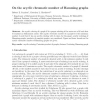27 search results - page 3 / 6 » On the fractional chromatic number and the lexicographic pro... |
DM
2010
13 years 7 months ago
2010
The Grundy number of a graph G, denoted by (G), is the largest k such that G has a greedy k-colouring, that is a colouring with k colours obtained by applying the greedy algorithm...
DM
2010
13 years 7 months ago
2010
A labeling of a graph G is distinguishing if it is only preserved by the trivial automorphism of G. The distinguishing chromatic number of G is the smallest integer k such that G ...
EJC
2008
13 years 7 months ago
2008
Let D be a set of positive integers. The distance graph generated by D, denoted by G(Z, D), has the set Z of all integers as the vertex Supported in part by the National Science ...
GC
2008
Springer
13 years 7 months ago
2008
Springer
An acyclic coloring of a graph G is a proper coloring of the vertex set of G such that G contains no bichromatic cycles. The acyclic chromatic number of a graph G is the minimum nu...
COMBINATORICS
2006
13 years 7 months ago
2006
Two sets are non-crossing if they are disjoint or one contains the other. The noncrossing graph NCn is the graph whose vertex set is the set of nonempty subsets of [n] = {1, . . ....

